Learn how insurance agents can guide clients through proven safety protocols, mental health support, and equipment standards to build stronger, safer workplaces.
Please note: the following content was developed for educational purposes only and covers a wide variety of general workplace safety concerns and considerations, some not relevant to workers’ compensation or commercial auto coverage.
Why Workplace Safety Should Be a Top Priority
For small business owners, workplace safety can take a back seat to more immediate concerns like payroll, staffing, or customer service. However, neglecting workplace safety can come at a significant financial cost. According to survey findings, if small businesses were able to prevent just half of workplace injuries, they could save an average of $10,000 or more annually in out-of-pocket expenses related to workers’ compensation, medical care, and legal fees.
However, the cost of neglecting safety can be steep. The average cost of a workplace injury can exceed $10,000, once medical bills, lost productivity, and higher workers’ compensation premiums are considered.
More importantly, workplace injuries can affect employee morale, trust, and the overall health of a company’s culture. Employees who feel unsafe or unsupported are more likely to leave or disengage. For small businesses. where each team member plays a critical role, this disruption could have serious consequences.
By reducing preventable injuries, businesses can potentially lower their insurance costs and avoid claims, as well as improve retention, performance, and peace of mind.
What the 2025 Workplace Safety Report Reveals
Workplace safety is more than a regulatory concern, it’s a key part of running a stable, resilient business. For small businesses in particular, even one injury can lead to major disruptions and unexpected expenses. That’s why Pie Insurance’s 2025 State of Workplace Safety Report offers timely insights into the evolving risks small businesses face and the strategies they’re using to stay ahead of them.
The report, based on a national survey of over 1,000 U.S. small business decision-makers, reveals that workplace injuries remain both common and, in many cases, preventable.
Here are a few of the report’s most interesting findings:
- 75% of small businesses experienced workplace injuries in the past year. The most common types were mental health-related injuries (22%), slips, trips, and falls (20%), cuts and lacerations (18%), and overexertion or repetitive strain injuries (13%).
- Half of these injuries were considered preventable. That includes 59% of slips, trips, and falls; 47% of cuts and lacerations; and even 31% of mental health-related injuries— showing that with the right measures in place, many incidents could be avoided.
- The financial impact is significant. Based on survey data, small businesses could save an average of $10,000 or more annually in out-of-pocket costs (including workers’ compensation, medical expenses, and legal fees) by preventing just half of these injuries.
- Improvising safety measures is common— and costly. Nearly half (49%) of small businesses reported improvising safety practices due to a lack of proper equipment. These businesses also experienced more frequent lost workdays and higher injury-related expenses.
- Mental health is seen asa a growing risk. In fact, 46% of business leaders identified mental health as the top safety concern for their workforce, yet many still lack formal protocols to address it.
- AI adoption is on the rise. 81% of small businesses are open to using artificial intelligence for workplace safety, and 44% are already putting it into practice— with many reporting improvements in both efficiency and injury prevention.
These findings point to a clear takeaway: many workplace injuries can be prevented with smarter planning, better tools, and a more proactive safety culture. By understanding the data and applying it to their own operations, employers can play a pivotal role in improving outcomes and reducing claims.
Common Preventable Workplace Injuries
The types of injuries that show up most frequently, and are most often preventable, include:
- Slips, trips, and falls. Wet floors, uneven surfaces, or cluttered walkways are common contributors.
- Repetitive strain injuries. These are often caused by poor ergonomics or repeated movements without sufficient breaks.
- Cuts and lacerations. These injuries often result from improper equipment use or a lack of safety gear.
- Back injuries. Improper lifting techniques or a failure to use assistive devices play a significant role.
- Vehicle-related accidents. These are especially relevant for businesses with commercial vehicles and are often cause by distracted or fatigued driving.
Helping recognize these common risks is the first step toward preventing them.
Actionable Safety Tips for Small Businesses
Improving workplace safety does not require a major overhaul. Many improvements come down to consistency, communication, and accountability.
1. Conduct Regular Safety Audits
Safety audits help identify hazards before they result in injury. Business owners should walk through their workplaces regularly to check or risks such as exposed wires, slippery floors, or malfunctioning equipment. It is also important to review training records and update any outdated procedures. All findings should be documented and followed up with appropriate action.
2. Provide Ongoing and Engaging Safety TraiFaing
Training should not be a one-time event. Regular sessions keep safety front and center and allow businesses to update employees on new procedures or risks. Employers should tailor training sessions to different job roles and make them interactive using quizzes, demonstrations, or real-life examples to keep employees engaged.
3. Ensure Proper Equipment and Personal Protective Equipment (PPE)
Inadequate equipment or missing PPE creates serious risks. Your clients should make sure that all tools and machines are functioning properly and that employees have access to and know how to use their protective gear. Clients should replace damaged gear promptly and consistently enforce PPE usage.
4. Establish Clear Safety Protocols and Accountability
A workplace without clear, consistent rules is more prone to accidents. Employers are encouraged to document all safety procedures and ensure that these are visible and understood by every employee. Assigning safety leaders or team coordinator scan also help reinforce accountability and create a stronger safety culture.
5. Support Employee Mental Health and Well-being
Fatigue, burnout, and stress are major contributors to workplace accidents. Businesses should consider offering employee assistance programs, flexible scheduling, and wellness initiatives to support both physical and mental health. Encouraging open communication between employees and management also helps prevent issues from escalating.
Commercial Auto Insurance and Vehicle Safety
For businesses with vehicles on the road, commercial auto insurance is an essential part of their risk profile. Here are a few ways you can promote vehicle safety and reduce the likelihood of claims:
- Implement driver safety programs that cover defensive driving techniques, fatigue management, and strategies to avoid distractions behind the wheel.
- Consider using telematics or vehicle monitoring systems to track driving behavior and identify areas for improvement.
- Maintain regular service schedules for all company vehicles to reduce the risk of mechanical failures and unsafe conditions.
Accidents involving business vehicles can be among the most expensive claims. Many of them may be preventable with proper oversight and training.
Prevention Is Better Than the Cure
Helping reduce your small business’s risk of injury Is not just about compliance or managing costs. It is about building stronger, more resilient companies. A safe workplace attracts better employees, increases productivity, and fosters a culture of responsibility and trust.
Blog courtesy of our partner Pie Insurance.

